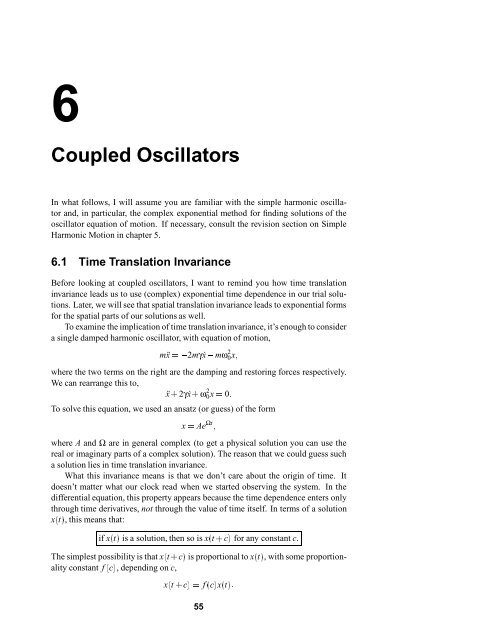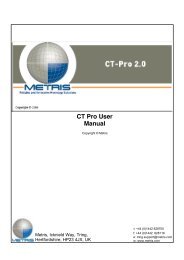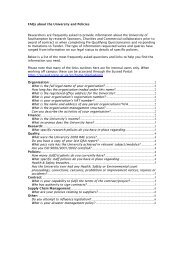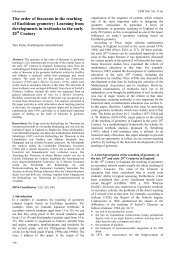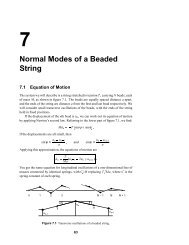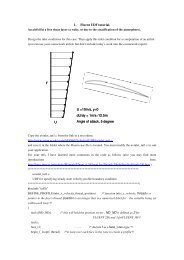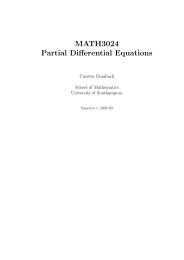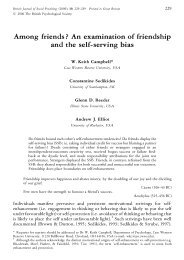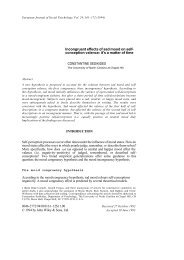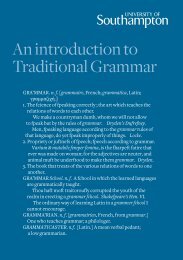6 Coupled Oscillators
6 Coupled Oscillators
6 Coupled Oscillators
You also want an ePaper? Increase the reach of your titles
YUMPU automatically turns print PDFs into web optimized ePapers that Google loves.
6<br />
<strong>Coupled</strong> <strong>Oscillators</strong><br />
In what follows, I will assume you are familiar with the simple harmonic oscillator<br />
and, in particular, the complex exponential method for finding solutions of the<br />
oscillator equation of motion. If necessary, consult the revision section on Simple<br />
Harmonic Motion in chapter 5.<br />
0x=0: 0x;<br />
6.1 Time Translation Invariance<br />
Before looking at coupled oscillators, I want to remind you how time translation<br />
invariance leads us to use (complex) exponential time dependence in our trial solutions.<br />
Later, we will see that spatial translation invariance leads to exponential forms<br />
for the spatial parts of our solutions as well.<br />
To examine the implication of time translation invariance, it’s enough to consider<br />
a single damped harmonic oscillator, with equation of motion,<br />
mẍ=2mγẋmω 2<br />
where the two terms on the right are the damping and restoring forces respectively.<br />
We can rearrange this to,<br />
ẍ+2γẋ+ω 2<br />
To solve this equation, we used an ansatz (or guess) of the form<br />
x(t+c)=f(c)x(t):<br />
55<br />
x=Ae Ωt;<br />
where A and Ω are in general complex (to get a physical solution you can use the<br />
real or imaginary parts of a complex solution). The reason that we could guess such<br />
a solution lies in time translation invariance.<br />
What this invariance means is that we don’t care about the origin of time. It<br />
doesn’t matter what our clock read when we started observing the system. In the<br />
differential equation, this property appears because the time dependence enters only<br />
through time derivatives, not through the value of time itself. In terms of a solution<br />
x(t), this means that:<br />
if x(t)is a solution, then so is x(t+c)for any constant c.<br />
The simplest possibility is that x(t+c)is proportional to x(t), with some proportionality<br />
constant f(c), depending on c,
ẋ(t)=Ωx(t);<br />
Ωt:<br />
56 6 <strong>Coupled</strong> <strong>Oscillators</strong><br />
We can solve this equation by a simple trick. We differentiate with respect to c and<br />
then set c=0to obtain<br />
where Ω is just the value of ḟ(0). The general solution of this linear first order<br />
differential equation is<br />
x(t)=Ae<br />
We often talk about complex exponential forms because Ω must have a non-zero<br />
imaginary part if we want to get oscillatory solutions. In fact, from now on I will let<br />
Ω=iω, so that ω is real for a purely oscillatory solution.<br />
We can’t just use any value we like for ω. The allowed values are determined by<br />
demanding that Ae iωt actually solves the equation of motion:<br />
(ω 2+2iγω+ω<br />
If we are to have a non-trivial solution, A should not vanish. The factor in parentheses<br />
must then vanish, giving a quadratic equation to determine ω. The two roots of the<br />
quadratic give us two independent solutions of the original second order differential<br />
equation.<br />
6.2 Normal Modes<br />
n(t)):<br />
We want to generalise from a single oscillator to a set of oscillators which can affect<br />
each others’ motion. That is to say, the oscillators are coupled.<br />
If there are n oscillators with positions x i(t)for i=1;:::;n , we will denote the<br />
“position” of the whole system by a vector x(t)of the individual locations:<br />
x(t)=(x 1(t);x 2(t);:::;x The individual positions x i(t)might well be generalised coordinates rather than real<br />
physical positions.<br />
The differential equations satisfied by the x i iωt;<br />
will involve time dependence only<br />
through time derivatives, which means we can look for a time translation invariant<br />
solution, as described above. This means all the oscillators must have the same<br />
complex exponential time dependence, e iωt , where ω is real for a purely oscillatory<br />
motion. The solution then takes the form,<br />
x(t)=0B@A 1<br />
A 2<br />
n1CAe .<br />
A<br />
where the A i are constants. This describes a situation where all the oscillators move<br />
with the same frequency, but, in general, different phases and amplitudes: the oscillators’<br />
displacements are in fixed ratios determined by the A i . This kind of motion<br />
is called a normal mode. The overall normalisation is arbitrary (by linearity of the<br />
differential equation), which is to say that you can multiply all the A i by the same<br />
constant and still have the same normal mode.<br />
Our job is to discover which ω are allowed, and then determine the set of A i<br />
corresponding to each allowed ω. We will find precisely the right number of normal<br />
modes to provide all the independent solutions of the set of differential equations.<br />
For n oscillators obeying second order coupled equations there are 2n independent<br />
2<br />
0)Ae iωt=0:
6.3 <strong>Coupled</strong> <strong>Oscillators</strong> 57<br />
solutions: we will find n coupled normal modes which will give us 2n real solutions<br />
when we take the real and imaginary parts.<br />
Once we have found all the normal modes, we can construct any possible motion<br />
of the system as a linear combination of the normal modes. Compare this with<br />
Fourier analysis, where any periodic function can be expanded as a series of sines<br />
and cosines.<br />
6.3 <strong>Coupled</strong> <strong>Oscillators</strong><br />
Take a set of coupled oscillators described by a set of coordinates q 1;:::;q n . In<br />
general the potential V(q)will be a complicated function which couples all of these<br />
oscillators together. Consider small oscillations about a position of stable equilibrium,<br />
which (by redefining our coordinates if necessary) we can take to occur when<br />
q i=0 for i=1;:::;n. Expanding the potential in a Taylor series about this point,<br />
we find,<br />
V(q)=V(0)+∑<br />
∂V<br />
q i+1<br />
i<br />
∂q i0 2 ∑ j0;<br />
j+:<br />
∂ 2 V<br />
q i q<br />
i;j<br />
∂q i ∂q j0<br />
By adding an overall constant to V we can choose V(0)=0. Since we are at a<br />
position of equilibrium, all the first derivative terms vanish. So the first terms that<br />
contribute are the second derivative ones. We define,<br />
K i j∂2 V<br />
∂q i ∂q<br />
and drop all the remaining terms in the expansion. Note that K i j is a constant symmetric<br />
(why?) nn matrix. The corresponding force<br />
j;<br />
is thus<br />
F i=∂V<br />
i=∑K i j q j<br />
∂q<br />
j<br />
and thus the equations of motion are<br />
K i j q<br />
for i=1;:::;n. Here the M i are the masses of the oscillators, and K is a matrix of<br />
‘spring constants’. Indeed for a system of masses connected by springs, with each<br />
mass moving in the same single dimension, the coordinates can be taken as the real<br />
position coordinates, and then M is a (diagonal in this case) matrix of masses, while<br />
K is a matrix determined by the spring constants. Be aware however, that coupled<br />
oscillator equations occur more generally (for example in electrical circuits) where<br />
the q i s need not be actual coordinates but more general parameters describing the<br />
system (known as generalised coordinates) and in this case M and K play similar<br />
rôles even if they do not in actuality correspond to masses and spring constants.<br />
To simplify the notation, we will write the equations of motion as a matrix equation.<br />
So we define,<br />
M=0B@M 1 1n<br />
2n<br />
.<br />
. . .. . .<br />
. . .. .<br />
0 0M<br />
M i ¨q i=∑<br />
j<br />
nn1CA:<br />
00 n1CA;K=0B@K 11 K 12K 0 M 20<br />
K 21 K 22K K n1 K n2K
k0<br />
58 6 <strong>Coupled</strong> <strong>Oscillators</strong><br />
x 1 x 2<br />
k1<br />
m 1 m 2 k 2<br />
Figure 6.1 Two coupled harmonic oscillators. The vertical<br />
n1CA:<br />
dashed lines mark the equilibrium<br />
positions of the two masses.<br />
Likewise, let q and ¨q be column vectors,<br />
q=0B@q 1<br />
n1CA;¨q=0B@¨q<br />
q 2<br />
A:<br />
1<br />
¨q 2<br />
.<br />
.<br />
q ¨q<br />
With this notation, the equation of motion is,<br />
M ¨q=Kq;or<br />
Kq;<br />
¨q=M1<br />
where M1 is the inverse of M.<br />
Now look for a normal mode solution, q=Ae iωt , where A is a column vector.<br />
We have ¨q=ω 2 q, and cancelling e iωt factors, gives finally,<br />
M1 KA=ω 2<br />
This is now an eigenvalue equation. The squares of the normal mode freqencies are<br />
the eigenvalues of M1 K, with the column vectors A as the corresponding eigenvectors.<br />
6.4 Example: Masses and Springs<br />
As a simple example, let’s look at the system shown in figure 6.1, comprising two<br />
masses m 1 and m 2 constrained to move along a straight line. The masses are joined<br />
by a spring with force constant k0, and m 1 (m 2 ) is joined to a fixed wall by a spring<br />
with force constant k 1 (k 2 ). Assume that the equilibrium position of the system has<br />
each spring unstretched, and use the displacements x 1 and x 2 of the two masses away<br />
from their equilibrium positions as coordinates. The force on mass m 1 is then<br />
F 1=k 1 x 1k0(x 1+k0k0 1): 2) 1x 2 x 2k0(x 2x (Note that these follow from a potential of form V=1<br />
2 k 1x 2 1+1<br />
2 k0(x 2x 1)2+1<br />
2 k 2x 2 2 .)<br />
You can check that Newton’s 2nd law thus implies, in matrix form:<br />
2:<br />
1<br />
2=k 2+k0x 1<br />
ẍ k0k x<br />
The eigenvalue equation we have to solve is:<br />
2A 1 2A 2=ω 1<br />
k0=m 2(k A A<br />
and on mass m 2<br />
F 2=k<br />
m 1 0<br />
2ẍ<br />
0 m<br />
(k 1+k0)=m 1k0=m 1<br />
2+k0)=m
2;<br />
6.4 Example: Masses and Springs 25λ+4=0;<br />
59<br />
Now specialise to a case where m 1=m, m 2=2m,<br />
0:<br />
k 1=k, k 2=2k and k0=2k.<br />
The eigenvalue equation becomes,<br />
32<br />
2A 1<br />
2=m<br />
ω2A 1<br />
1 A k A<br />
or, setting λ=mω 2=k,3λ2<br />
2λA 1<br />
2=0<br />
1 A<br />
For there to be a solution, the determinant of the 22 matrix in the last equation<br />
must vanish. This gives a quadratic equation for λ,<br />
λ<br />
with roots λ=1 and λ=4. The corresponding eigenfrequencies are ω=pk=m<br />
and ω=2pk=m. For each eigenvalue, there is a corresponding eigenvector. With<br />
λ=1you find A 2=A m;<br />
1 , and with λ=4 you find A 2=A 1;<br />
1=2. Note that just the<br />
ratio of the two A i is determined: you can multiply all the A i by a constant and stay<br />
in the same normal mode. This means that we are free to normalise the eigenvectors<br />
as we choose. It is common to make them have unit modulus, in which case the<br />
eigenfrequencies and eigenvectors are:<br />
A=1p21<br />
ω=2rk<br />
m; A=1p521;<br />
ω=rk<br />
In the first normal mode, the two masses swing in phase with the same amplitude,<br />
and the middle spring remains unstretched. This could have been predicted: we have<br />
solved for a case where m 2 is twice the mass of m 1 , and is attached to a wall by a<br />
spring with twice the force constant. Therefore, m 1 and m 2 would oscillate with the<br />
same frequency in the absence of the connecting spring.<br />
In the second mode the two masses move out of phase with each other, and m 1<br />
has twice the amplitude of m 2 .<br />
6.4.1 Weak Coupling<br />
m;<br />
and Beats<br />
Now consider a case where the two masses are equal, m 1=m 2=m, and the two<br />
springs attaching the masses to the fixed<br />
m; walls are identical, k<br />
1;<br />
1=k 2=k. From the<br />
symmetry of the setup, you expect one mode where the two masses swing in phase<br />
with the same amplitude, the central connecting spring remaining unstretched. In<br />
the second mode, the two masses again have the same amplitude, but swing out of<br />
phase, alternately approaching and receding from each other. This second mode will<br />
have a higher frequency (why?).<br />
If the spring constant of the connecting spring is k0=εk, you should check that<br />
applying the solution method worked through above gives the following eigenfrequencies<br />
and normal modes:<br />
A 1=1p21<br />
A 2=1p21<br />
1=rk<br />
ω<br />
2=r(1+2ε)k<br />
ω
60 6 <strong>Coupled</strong> <strong>Oscillators</strong><br />
0;<br />
t):<br />
When the connecting spring has a very small force constant, ε1, so that the<br />
coupling is weak, the two normal modes have almost the same frequency. In this<br />
case it’s possible to observe beats when a motion contains components from both<br />
normal modes. For example, suppose you start the system from rest by holding the<br />
left hand mass with a small displacement to the right, say d, keeping the right hand<br />
mass in its equilibrium position, and then letting go.<br />
A general solution for the motion has the form,<br />
2 A 2 cos(ω 2 t)+c 3 A 1<br />
1;<br />
sin(ω 1 t)+c 4 A 2 sin(ω 2<br />
Because the system starts from rest, you can immediately see (make sure you can!)<br />
that c 3=c 4=0in<br />
t));<br />
this case. Then the initial condition,<br />
x(0)=d<br />
gives, d<br />
0=c p21 1<br />
1+c p21 2<br />
t)):<br />
which is solved by c 1=c 2=d=p2. So, the motion is given by:<br />
1(t)=d<br />
x 1 t)+cos(ω 2<br />
2(cos(ω 2(t)=d<br />
t: t;<br />
x 1 t)cos(ω 2<br />
2(cos(ω We can rewrite the sum and difference of cosines as products, leaving:<br />
2ω x cosω<br />
1(t)=d 1<br />
1+ω 2<br />
tcosω<br />
2<br />
2<br />
2ω x sinω<br />
2(t)=d 1<br />
1+ω 2<br />
tsinω<br />
2<br />
2<br />
Now you can see that each of x 1 and x 2 has a “fast” oscillation at the average frequency(ω<br />
1+ω 2)=2, modulated by a “slow” amplitude variation at the difference<br />
frequency(ω 2ω 1)=2. The displacements show the contributions of the two normal<br />
modes beating together, as illustrated in figure 6.2.<br />
You can easily demonstrate beats by tying a length of cotton between two chairs<br />
and hanging two keys from it by further equal-length threads. Each key is a simple<br />
pendulum and the suspension thread provides a weak coupling between them. Start<br />
the system by pulling one of the keys to one side, with the other hanging vertically,<br />
and releasing, so that you start with one key swinging from side to side and the<br />
other at rest. The swinging key gradually reduces its amplitude, and at the same<br />
time the other key begins to move. Eventually, the first key will momementarily<br />
stop swinging, whilst the second key has reached full amplitude. The process then<br />
continues, and the swinging motion transfers back and forth between the two keys.<br />
x(t)=c 1 A 1 cos(ω 1 t)+c
6.4 Example: Masses and Springs 61<br />
1(t) x<br />
2(t) x<br />
d<br />
d<br />
5 10 15 20<br />
ω 1 t<br />
2π<br />
d<br />
5 10 15 20<br />
ω 1 t<br />
2π<br />
d<br />
Figure 6.2 Displacements x 1 and x 2 as functions of time, starting with both masses at rest<br />
and x 1(0)=d, x 2(0)=0. The displacement curve for x 2 is shown dashed. For this plot, the<br />
ratio ε of the spring force constants of the coupling (central) spring and either of the outer<br />
springs is 0:1. Time is plotted in units of the period of the lower frequency normal mode.
62 6 <strong>Coupled</strong> <strong>Oscillators</strong>


